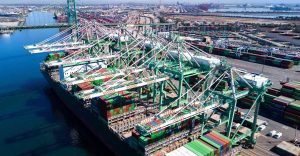The list of three major seaports in Cambodia, including Sihanoukville, Phnom Penh, and Kampot, has long been an important destination for trade and logistics activities. Each year, these ports collectively contribute over 20% to Cambodia’s GDP. With large volumes of cargo being transported through the ports, logistics operations at Cambodia’s seaports create employment opportunities and income for thousands of people, as evidenced in annual meetings. The development of these ports not only enhances the country’s economic status but also facilitates international trade cooperation and economic connections with neighboring countries. Furthermore, with maritime links to ports around the world, Cambodia’s seaports also play a crucial role in strengthening global trade and economic cooperation.
1. Sihanoukville Deep-Sea Port – Cambodia’s Largest
Sihanoukville Port, one of Cambodia’s oldest ports, has been operating since the 1960s. Located strategically in the southern part of the country, beside the Gulf of Thailand, the port covers a large area of approximately 1,800 hectares, making it a significant destination for trade and logistics. Each year, the port handles about 4 million tons of cargo, with a water depth of approximately 11 meters, capable of accommodating large vessels. Although it is about 230 km from the capital Phnom Penh, Sihanoukville Port still plays a critical role in Cambodia’s economy through international and domestic trade activities. The port is particularly important for trade between Cambodia and Vietnam.
– **Shipping costs**: Shipping costs from Sihanoukville Port to Cat Lai Port typically range from $50 to $100 USD per TEU (equivalent to a 20-foot container), depending on the type of goods, timing, and shipping line.
– **Sea transport time**: The sea transport time from Sihanoukville Port to Cat Lai Port is usually around 2 to 3 days, depending on the ship’s schedule and speed.
2. Phnom Penh Port
Phnom Penh Port, located along the Saigon River (or Hau River), a tributary of the Mekong River, has been operating since the 1960s. Strategically located in the capital city of Phnom Penh, the port plays an important role in connecting domestic and international trade. Although the port’s area is not as large as other major ports, approximately 200 hectares, it still handles around 2 million tons of cargo annually, contributing to Cambodia’s economic development. With a water depth of about 5-6 meters, the port accommodates various ships and cargo. Additionally, Phnom Penh Port plays a crucial role in fostering trade between Cambodia and Vietnam through inland waterway and road transportation links.
– **Shipping costs**: Shipping costs from Phnom Penh Port to Cat Lai Port are typically similar to those from Sihanoukville Port.
– **Sea transport time**: Due to the port’s location on the river and its distance from the sea, transporting goods from Phnom Penh Port to Cat Lai Port typically takes an additional 1 to 2 days compared to Sihanoukville.
3. Kampot Seaport
Kampot Port, although smaller compared to other ports, still plays an important role in facilitating trade in the region. With its history dating back to the 1950s and its location near the Kampot River and the Gulf of Thailand, the port is a key destination for transport and logistics activities in the area. Each year, the port handles around 500,000 tons of cargo, with a water depth of about 3-4 meters, sufficient for smaller vessels. While it is only about 5 km from Kampot town, Kampot Port contributes to local economic development and provides one of the main outlets for trade between Cambodia and Vietnam.
– **Shipping costs**: Due to the smaller scale of Kampot Port and the lack of large vessels like other major ports, shipping costs from here to Cat Lai Port may be slightly higher, around $60 to $120 USD per TEU.
– **Sea transport time**: Transport time from Kampot Port to Cat Lai Port is typically similar to Sihanoukville, around 2 to 3 days.
The above article provides important information about the seaports in Cambodia and their impact on the country’s economy. However, if you would like to learn more details about each seaport, including services and infrastructure, you can visit Boom Logistics’ website for further details and updates on the logistics industry in Cambodia. Through this, you will gain a better understanding of the significant role of seaports in driving the economic development of the country and connecting to the global market.






